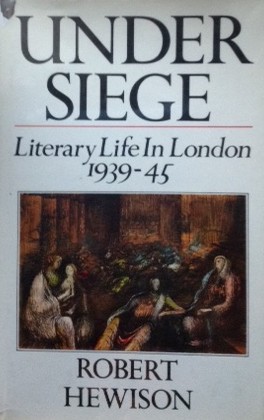Inspiring Older Readers
 posted on 30 Apr 2017
posted on 30 Apr 2017
Under Siege: Literary Life in London 1939-45 by Robert Hewison
When this book appeared in 1977 it was pretty much the first dedicated analysis of what it was like trying to be a professional writer throughout the Second World War. To my mind it remains one of the most readable accounts even today and I think it is particularly admirable in being succinct and not seeking to convince the reader that length and bulk are in some way synonymous with real scholarship.
Initially it may seem typically, even arrogantly, metropolitan to focus exclusively on London but the current day influence of the provinces and municipalities on literary life in the 21st century is a relatively recent phenomenon. Back in 1938 as the country prepared for war, the centre of literary life was undoubtedly London. It's capacity to draw writers and artists to it was almost irresistible and only those with a really strong sense of regional loyalty could resist its allure.
So, when war was declared in 1939 it was the literary establishment of London who are best studied in order the understand the impact on writers as individuals and on literature as a cultural phenomenon.
Hewison describes how the war had an immediate and depressing impact on writers - both practically and spiritually. In practical terms the outlets for writers work became increasingly difficult to find as magazines were closed down and paper became a scarce commodity. It was also feared that the public taste for reading was likely to diminish as their minds became preoccupied with issues of survival.
But on top of this writers themselves began to question the purpose of their role and a sort of despair or spiritual malaise pervaded the atmosphere:
'Writers themselves, although they had known what was coming, felt stunned and unable to work. Dylan Thomas wrote frankly: "I want to get something out of the war, and put very little in (certainly not my one and only body)." He like every other professional writer found that all sources of income there were dried up.'
The need to earn a living for those who did not sign up for the armed forces saw many authors, like George Orwell, working for propaganda or official bureaucratic channels like the BBC until they simply couldn't take any more. The book describes these lean years with real brio and this first half was, for me at least, the strongest and most engaging. In particular his section on the emergence of Fitzrovia as the sort of unofficial literary bolt-hole or writers ghetto is especially entertaining and I wasn't at all surprised to find that it was predominantly pubs that defined the territory.
Hewison goes on to look at the gradual reemergence of writing and the growing popularity of reading as an escape from war's realities. He explores both prose and poetry and pulls no punches in finding both distinctly second rate when taken en bloc. He sides with those critics who felt that much of the writing was bland and unadventurous - a sort of default to middle-brow taste as the safe haven - and, as is often the case, he quotes Cyril Connolly's typically acute commentary:
'We are becoming a nation of culture- diffusionists. Culture-diffusion is not art. We are not making true art....We are turning all our writers into commentators until one day there will be nothing left for them to comment on.'
In the end Hewison's rather bleak assessment of the sterility of the war years is something he himself acknowledges but without apology:
'If the closing pages of this book are depressing, it is because the times they describe are depressing...Yet if the end of the war years was a depressing time, the next years would be worse.'
The onset of the Cold War had a bitter and biting impact on what literary life remained when the hostilities of the shooting war were over. Writers who had come together in adversity drifted apart, whatever kind of community had been created was lost. Crucially however 'as competition increased from easier forms of entertainment, books themselves lost the advantage they had had during the war.'
What Hewison's does so well is to both describe what war does to culture but he also highlights the fact that what we call 'culture' is in the hands of human beings, artists - writers, painters, actors, musicians - who as individuals are likely to be psychologically and financially damaged by the experience of war. Ultimately, war has a long reach and, if Hewison is right in his analysis, it has a cold, dead hand.
This is a book of not much more than 180 pages but I found it a fascinating and absorbing description of a period we simply tend to gloss over as 'the war years'. Copies wont cost you more than a few pounds on the second hand market and the hardback has a great jacket that features on of Henry Moore's legendary underground shelter sketches.
Terry Potter
April 2017